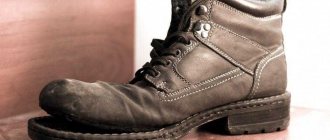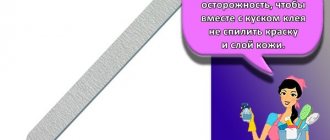Hot air
You can stretch the boots so that they do not rub when you first put them on using vegetable oil and a hairdryer.
This method is suitable for thin leather products.
How to soften shoes:
- Treat the entire surface with vegetable oil or cream.
- To make your shoes softer, wear them with a thin sock.
- Turn on the hairdryer, but the air flow should not be very hot, but warm. Point the hair dryer at the product and warm it up thoroughly.
After completing the procedure, you do not need to immediately wipe off the oil. Walk around in the shoes for a while, wait until they cool down and take the shape of your feet. Then you can remove the product and wipe off the vegetable oil with soapy water.
The fastest way to soften shoes
To make your shoes comfortable, you can use the old army method. It allows you to make even the roughest shoes soft and comfortable, like home slippers. To do this you need:
- The skin should be thoroughly moisturized from the inside. This can be done with water or a special stretching foam;
- On the part of the shoe that needs to be made soft, you need to spread a soft cloth soaked in liquid. Flannel or felt is suitable for these purposes;
- Using a hammer, you need to carefully beat off the prepared area. In this case, you need to try not to damage the shoes, the lighter the better;
- During the entire process, it is important to check how soft the skin has become.
Boiling water or beer
Both products are good if you need to soften suede products. Boiling water and beer are suitable for suede as they do not leave marks.
The outside of suede cannot be wet. This material is very sensitive to moisture.
How to soften:
- Spray the inside with beer, then put on socks and walk around in them for a bit. It is better to set aside the whole day for the procedure in order to properly break in the shoes.
- Boil water in a kettle. Fill the suede shoes to the brim, after 5 seconds pour out the water. Put your boots on immediately and walk around the house in them until the material cools down.
Boiling water can also be used on genuine leather shoes. It withstands high temperatures well.
Boiling water cannot be used for leatherette. The material may burst when heated. Also, a hairdryer is not suitable for leatherette.
Is it possible to return (change, return)?
According to the current legislation of the Russian Federation, two types of guarantee apply to purchased shoes:
- Exchange guarantee;
- Quality assurance.
This is interesting: Which product can best remove unpleasant odor from shoes: spray, powder, balls or folk remedies
In the first case, this means that within 14 days from the date of purchase you can contact the store and ask to exchange the product for a more suitable one. Possibly with an additional charge. This can be done if the product does not fit you in size, you are not satisfied with the shape, style, color, or the package is incomplete.
Important! In addition to the product itself, you need to have its packaging and a receipt confirming the fact of purchasing the shoes. In addition, all factory tags must remain intact.
The quality guarantee implies that the customer can return a product that has been found to have a manufacturing defect. In this case, an examination is appointed, during which the causes of the defect are determined. If it really is the manufacturer's fault:
- The consumer is provided with another pair of shoes, but of appropriate quality;
- Or repairs are carried out free of charge.
The seller has 20 days for this.
After the specified period, in the absence of any action on his part, the buyer has the right to a refund.
You can take advantage of this opportunity if you suddenly discover after the purchase that:
- Paint is falling off shoes;
- The sole has come off or worn out (if the shoes have been worn for no more than 3 months);
- The seams are broken.
Attention! Only shoes that have retained their salable condition are accepted for return, repair or exchange.
You will not be able to use the guarantee if you:
- The shoes were damaged in the process of self-repair (only replacing the heels and gluing a preventive outsole is allowed if this does not result in defects);
- The product was worn in conditions not intended for this purpose (out of season);
- The product was accidentally damaged in some other way during use.
Therefore, try to handle the product as carefully as possible until you finally understand whether it suits you. Otherwise, all you can do is give it as a gift to someone or resell it.
Shoemaker tips
In order to avoid all sorts of problems associated with rubbing shoes, follow a few simple recommendations when choosing them:
- Don’t rush to buy the first pair you come across, even if, at first glance, it fits your feet perfectly. Walk around the store in it for a couple of minutes. Sometimes the feeling of discomfort does not appear immediately;
- You shouldn't buy a smaller model than you need just because it looks more attractive. During wear, the shoes will still not stretch to the size you need, but problems with the health of your feet are guaranteed to make themselves felt;
- Buying shoes that are more spacious than necessary is not protection against chafing. The material will also come into contact with the skin in unnecessary places, causing pain;
- Pay attention to the quality of tailoring. On the inner surface of the shoe there may be protruding pieces of fabric, seams and other unnoticeable details that will make themselves felt during your first walk. If you find them, it is better to refuse to buy a pair, despite its visual appeal;
- The best choice is products made from natural fabrics or leather with high-quality orthopedic lasts. They fit the leg well, leaving enough free space for comfortable wearing, and do not interfere with the access of oxygen. In addition, such materials stretch more easily, changing their shape if necessary and adapting to the physiological characteristics of your foot.
This is interesting: What to do if your sneakers are narrow and rub, how to wear them in
Remember that preventing the appearance of calluses is easier and better than getting rid of them later. And care when buying shoes is the first thing that is necessary for this.
Paraffin and soap
Hard shoes can be stretched at home using paraffin and soap.
This method is suitable if the products are needed in a few hours, and you need to distribute them quickly.
You can soften hard shoes in this way: rub them from the inside with a paraffin candle or soap. Put your shoes on right away.
This method is used for rough suede or genuine leather.
Paraffin and soap make shoes very soft. After using them, calluses will not appear on your feet.
Paraffin candle and solid soap
This method is suitable for those who need to put on shoes right away. Imagine you bought new shoes specifically for an upcoming event, after which you successfully placed them on the shelf and temporarily forgot about them. When it's time to take them out, you discover that the shoes are quite hard, and staying in them all evening is pure torture, and you have to leave the house in a few minutes. This is where a paraffin candle and bar soap come in handy.
They act on the material immediately, and due to their composition they will not only soften the shoes, but also protect the feet from calluses. You need to treat your shoes from the inside by simply rubbing them with paraffin. Immediately after this, you can safely put on your shoes. This method can also soften suede shoes.
Alcohol
Alcoholic drinks also soften well.
This method is not suitable for all materials, so before using it, check the reaction of the boots to alcohol, and only then use it for the procedure.
How to make shoes softer:
- Pour a small amount of vodka or rubbing alcohol into a spray bottle.
- Spray the product on the inside. Treat well those areas where the shoes are too tight.
- Then put on your shoes and walk around the house a little. You can stuff them with newspapers if they are wearing high heels and your feet are already chafing.
To replace alcohol and vodka, use regular cologne or perfume. They also contain some alcohol and can soften the material.
In addition, after using men's cologne or women's perfume, a pleasant aroma will emanate from the shoes for a long time.
Petrolatum
Vaseline is perfect for softening. This product is safe, but if you have allergic reactions to its composition, it is better not to use it. After all, the medicine will come into contact with the skin.
How to soften shoes so they don't rub:
- Take a small amount of Vaseline and treat the inside of the shoes in the toe area.
- Then go over the side walls.
- Pay special attention to the back. Rub the heel well; it is in these places that the material is most often coarser.
Leave the shoes alone for several hours. Vaseline should be well absorbed. Then put on warm socks and walk around the apartment in your shoes.
Vaseline is very cheap and is available for sale in every pharmacy.
What kind of discomfort can there be from “oaky” skin?
After purchasing shoes, you usually have to break them in before wearing them regularly. But it happens that expensive, high-quality leather shoes become stiff and begin to cause inconvenience, even though they are no longer new.
Most often this is observed in the following places:
- in the back area;
- in a sock;
- in the middle part;
- in the foot;
Discomfort is manifested by rubbing calluses and corns in the indicated places. In order to get rid of this phenomenon, you should try various methods of softening hard skin.
Cold
To implement this method, you will need to fill a plastic bag with cold water. It is placed inside the shoes that need to be stretched and the shoes are placed in the freezer.
When water turns into ice, it increases in volume, which is what causes stretching.
Just make sure the bag has no holes and is tied well.
How to remove an ice pack? You can't pull by force. Remove the boots from the freezer and place them in a warm place. When the ice melts a little, you can easily take out the bag and try on the shoes already stretched.
Freezing shoes
The freezing method is suitable for winter shoes, as they are impervious to cold. Be careful with artificial materials, unlike genuine leather, they can deteriorate.
Before placing shoes in the freezer, fill bags with water. They need to be placed in hard shoes and placed in the freezer overnight. As water freezes, it expands and softens uncomfortable shoes. In the morning, remove the pair from the freezer and let it defrost, first removing the bags of water.
Castor oil
Castor oil has a good effect on the material. New shoes should be immediately treated with this oil and walked around a little.
Castor oil can soften the butt well, and sometimes works better than other home remedies.
For an even better effect, mix castor oil, melted beeswax and turpentine. All components are taken in equal quantities.
This composition is rubbed inside and out. Thanks to these products, the shoes are well saturated with oils, the leather becomes softer and more elastic.
In addition, this mixture protects against the negative effects of moisture. During rain, droplets of water will not be absorbed into the material; they will remain on the fabric in the form of droplets and then flow down onto the asphalt.
Special Moments
Unfortunately, this opportunity is not always available. If it is still not there, then it is necessary to use various professional methods.
There are various chemicals available on the market that can soften shoe leather quickly and reliably. In particular, such products include creams and other products.
You can find them in standard hardware stores or contact shoe centers. Many workshops also offer their clients various products that can soften shoes.
It happens that consumers use creams designed for a person’s face or hands to soften their shoes. In principle, tanning uses skin that is somewhat similar to human skin, but the effect of such creams on it will be very weak.
It turns out that the effect of such products on softening shoes will be insufficient.
Softening shoes with glycerin
In principle, glycerin is a universal agent used in various formulations used in the care of leather products.
It is worth noting that glycerin is an alcohol compound in its composition, but it is non-aggressive, which is why it is used in a wide variety of substances. By using glycerin, shoes made of genuine leather can be made soft and quite comfortable.
The effect of glycerin is much stronger compared to the most reliable shoe polishes.
The product is quite easy to use - you just need to apply it to the area of the shoe that has begun to rub your foot, and leave it to soak in for a certain period of time. With the help of glycerin you can get rid of even quite extensive hardenings on the surface of leather shoes.
After some of this substance is absorbed, its excess is removed from the surface of the leather, and the shoes themselves are polished. As a result of such operations, leather shoes become very soft and comfortable to use.
Soften shoes with wax
The most ordinary wax left over from a candle will be a pretty good help for those who are going to make leather shoes softer.
The method of application is very simple - you need to melt the candle stub and apply a certain amount of wax substances to the surface of the difficult area.
When using this method, you should be quite careful - immediately after melting the candle, it is not advisable to apply wax to the skin, as it will be very hot - this can seriously damage the skin.
To soften your shoes, apply wax along with paraffin a couple of minutes after it melts.
After the shoes are waxed, they are left for a few minutes, then the substance is removed and the leather is polished.
Pork lard as a shoe softener
This method is the most environmentally friendly and harmless to both humans and shoes.
All the natural fats contained in lard will not cause harm, but will only bring benefit.
The main thing here is to use unsalted lard.
The application technology is as follows: cut off a small piece, which is then rubbed into the hardened area.
In principle, many people rub lard over the entire surface - this will allow them to avoid polishing their shoes for a long time. Natural animal fat can reliably protect shoes from the negative effects of moisture and temperature changes.
Kerosene
You can simultaneously soften the material and stretch it using kerosene.
How to soften shoes at home with this flammable product:
- First, the shoes must be wetted with warm water.
- They are then treated with kerosene. To do this, soak a cloth in the mixture and apply it to the surface of the shoe. Kerosene should not drain from them, just lightly treat the surfaces.
- Then the products should be dried.
This method is definitely good. However, after using it, your boots may smell unpleasant.
Take the boots out into the fresh air and leave them there until all the smell has disappeared.
How to soften leather on shoes at home?
In almost every apartment or nearby store you can find many tools to eliminate the inconvenience when wearing new shoes. Let's look at the most popular methods for softening the leather on the inside of shoes.
Hot air and boiling water
You should select the hot air mode on the device. You need to hold it in the direction of the area that needs softening for several minutes. If you use the liquid method, you need to pour a small amount of it inside the boots. After the procedure, you should put on woolen socks and walk for half an hour.
For the methods discussed, shoes made of real leather are suitable. She is not afraid of high temperatures, even up to three hundred degrees.
A gentle method is to use a box. You need to put your shoes in it and cover it with a lid. Dip a rag in hot water and wrap them. Softening faux leather shoes with the listed options is very risky.
Even if you can’t get a hairdryer for this purpose, warm water is available in any apartment. If it is turned off, you can heat it up.
Paraffin and soap
This method is used if you need to put on your shoes right away. For example, they were purchased a long time ago for a specific holiday. When the time came, it turned out that the shoes were hard and it was simply impossible to stay in them all evening.
A paraffin candle and solid soap will be lifesavers in this case. Thanks to their composition, the boots will not only become softer, but will also not leave damage to your feet. You need to rub the products from the inside and then put them on immediately. The method is suitable for hardened leather and suede.
Other methods
- alcohol. Alcohol has an aggressive effect, making boots softer. It requires a mandatory preliminary check in an inconspicuous area. Pour a little vodka or pure product into a spray bottle or apply to a cotton pad. Treat the necessary areas. Afterwards you need to walk around the apartment in your shoes for a while or put paper inside. Cologne is also used for this purpose;
- oil or Vaseline. The products will give not only softness, but also elasticity. This method is not suitable for light colors and suede; stains may remain on them or the color may change. Castor oil has the most intense effect; with its help you can tidy up even very thick skin. Application should be on the inside, after which you should walk a little in boots;
- cold. The method is used for shoes purchased for the winter season. It is designed for wear at low temperatures. Particular caution should be exercised regarding artificial variants. Pour water into bags, place in boots, and place in freezer overnight. The liquid will expand due to freezing and produce a softening effect. Upon awakening, take them out and take out the cellophane;
- special block. It can be purchased at shoe stores. The device looks like a screw structure made in the shape of a leg. You need to put a shoe on it and install it until it touches tightly. Wait a few hours, the material will become pliable and soft;
- kerosene. The product does the job effectively, but leaves a very pungent odor. Because of this, not everyone wants to use it. Discomfort will decrease if the procedure is carried out not indoors, but outdoors. At least on the balcony. The main thing is to completely remove the aroma from the shoes. Until this moment you should not wear them. Apply the liquid to the backdrop with a cotton pad, then wait a few hours;
- pork lard. The method is absolutely environmentally friendly and safe. The product should be used unsalted. Rub the problem area. You can also treat the surface so as not to polish the shoes. This will protect it from moisture;
- wax. The method is quite simple. Melt the candle and apply the product to the desired area. Be sure to wait until it cools completely so as not to cause harm to the skin;
- glycerin. It is not considered aggressive, but can easily handle a task. Treat areas that cause discomfort and wait a little. After removing excess liquid, polish;
- linseed oil, vinegar and petroleum jelly. The products are applied according to the same algorithm. The process occurs in different ways, but the impact is gentle. Apply the product and walk around the room.
Video: how to soften leather on shoes at home?
Special pad
Typically, such tools are used in workshops for shoe repair and stretching. But no one forbids having it at home.
Shoe stretching pads are sold in stores. They are shaped like a leg, so the material takes on the desired shape.
The special lasts also come with attachments that allow you to correct certain areas of your shoes.
If the shoes are made of leather
Don't wait until your boots or shoes wear out on their own. Leather, of course, is a completely elastic material, but, as a rule, the backs of fashion products remain rigid even after a year of active wear. But even if this happens in spite of everything, by that time your legs will have time to turn into a continuous wound.
The easiest way to help trouble is to beat it with a hammer. This method has been practiced for centuries. It is definitely not suitable for shoes:
- light;
- suede;
- varnished;
- decorated with various rhinestones and other elements.
In any case, we strongly do not recommend hitting unprotected material with a hammer. The procedure here will be as follows:
- cover the problematic backdrop with a soft cloth (thin felt or flannel);
- we use only a regular hammer (definitely not useful for meat) weighing up to 500 grams;
- We place a wooden block inside the product;
- lightly tap on the heel itself and on both sides;
- Next we strike from the inside out.
A more dangerous method is kneading with pliers:
- the backdrop is covered with a thick rag;
- clamped with a tool;
- bend in different directions.
None of the described methods can fix the boots.
Among chemical agents, we recommend that you first of all pay attention (if the shoes are not suede) to table vinegar. This substance is used according to the following instructions:
- the problem area is generously moistened with a 9% solution from the inside;
- apply a vinegar compress for about half an hour;
- the backdrop is kneaded by hand or with the same hammer;
- put plastic bags on their feet;
- put on their shoes and walk around the apartment for at least an hour.
If we are talking about boots, then after wetting the entire inner surface with vinegar, they are broken in by pulling on coarse knitted socks.
Glycerin is relatively safe - the problem is that it makes the skin too fragile over time. For this reason, after using it, shoes will have to be very intensively moisturized with a high-quality cream.
The procedure is as follows:
- A towel scalded with boiling water is placed inside the boots;
- when the pores open (after about a quarter of an hour), the back is rubbed with glycerin;
- shoes are placed in a bag and left overnight;
- In the morning they begin to break them in.
Stores now sell a lot of ready-made products for stretching shoes. They are not too expensive, but they act extremely delicately.
Finally, in any shoe shop, for a nominal fee, they will soften the backs and, if necessary, make the pair more spacious using sliding lasts.











